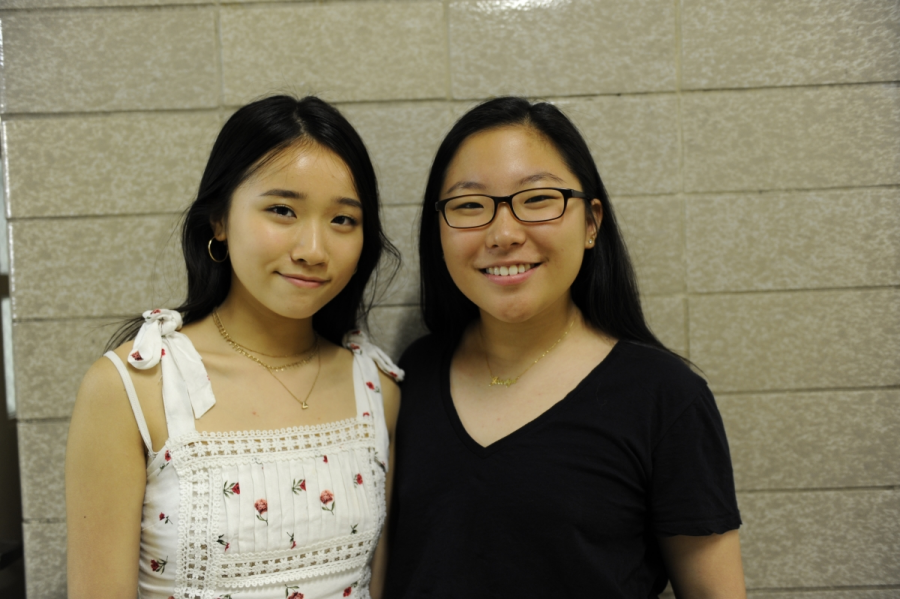Adaptive Clothing
Amy Liu ’19 (left) and Joselyn Kim ’19 (right) appreciate Tommy Hilfiger’s efforts to introduce inclusivity into the fashion industry.
For people with disabilities, getting dressed in the morning is often a time-consuming challenge. When mainstream retailers design clothing with only the able-bodied consumer population in mind, disabled individuals have a hard time finding clothes that work for them. With the limited number of brands that design clothes specifically for disabled people, it is difficult to find clothes in their personal style that are also functional.
Fortunately, this spring, renowned and prominent fashion designer Tommy Hilfiger has begun creating “adaptive clothing.” The clothes have specialized features, such as magnetic zippers, Velcro closures, adjustable hems, and magnetic buttons. With all these innovative features, kids and adults with disabilities no longer have to struggle with buttoning, zipping, and fitting into their clothes.
More importantly, Tommy Hilfiger has set precedent for other mainstream brands to start making adaptive clothing. In alliance with the non-profit organization ‘Runway of Dreams,’ Hilfiger urges the importance of inclusivity and making sure the customer is satisfied with their new clothes. Thanks to Hilfiger, MagnaReady, Cat & Jack, and Zappos have proposed their forthcoming lines for individuals with disabilities.
Hilfiger asserts that it is important to make sure that the customer feels comfortable and is able to express themselves through style. Hence, Hilfiger’s adaptive clothing line not only consists of disability-friendly features, but of beautiful patterns, silhouettes, and fabrics.
“I think it’s great that a big fashion brand is putting more awareness into designing clothing for disabled people. It is very unique, and I think it will inspire other brands to follow this approach,” said Amy Liu ’19.
More notably, the Spring 2018 collection for the disabled community supports a significant message of belonging and value. With the campaign featuring gold medal track star Jeremy Campbell, inspirational speaker Mama Caxx, dancer Chelsie Hill, and chef Jeremiah Josey, the disabled community can see these models as inspirations. They are role-models displaying the potential and the success of different icons in the disabled community. As Joselyn Kim ’19 said, “I think that Hilfiger’s Adaptive Clothing line is very innovative. Especially because the fashion industry doesn’t often think about the marginalized consumer populations such as disabled people when they design their clothes. This line definitely makes styling and dressing easier for disabled people.”
Similarly, other students applaud Hilfiger for being a prominent designer promoting the inclusivity in fashion. ““I think it’s great that a big fashion brand is putting more awareness into designing clothing for disabled people. It is very unique, and I think it will inspire other brands to follow this approach,” said Amy Liu ’19. Of course when thinking about the student body of Bronx Science, it is important to think about how this line will impact physically-disabled students. “I think it’s a fantastic way to create more fashion options for people with disabilities. Especially in high school, kids with disabilities feel isolated, and if they can express themselves more with style, they can feel belonged and fit in with their friend group,” said Mariam Van ’19. Overall, it seems that there is a positive feedback and reviews on the line.
Of course, Hilfiger has made a pivotal move for promoting inclusivity in the fashion world. However, can disabled individuals — who already spend tremendous amounts of money on medical costs — afford to spend an extravagant amount of money on this expensive clothing line? Will the new line truly promote inclusivity, or will it only represent the wealthier members of the disabled community?
It is evident that high school students, typically identified by personality and style, approve of the line, since it will allow disabled individuals to have a feeling of belonging. It is apparent that though some students praise the line, others believe that it is unfair that disabled individuals have to pay such high costs for clothing fit for them. After all, along with all the medical and surgical costs that are necessary expenses, spending hundreds on their clothing is not the most feasible way to maintain a healthy budget.
From a more political angle, the adaptive clothing line can be viewed as an American aesthetic of democracy. By meeting the demands and desires of the consumer population without prejudice to physical form, adaptive clothing designers promote inclusivity by breaking the status quo of the fashion industry. Although the debate over the high cost of the brand is an intensifying problem, society still applauds Hilfiger for being a role-model for other fashion companies. Of course, we await and hope that the future of the fashion industry introduces cheaper, stylish and of course, comfortable clothing for all.
Labiba Hasan is a Staff Reporter for ‘The Science Survey’ and the Sidebar Caption Editor for ‘The Observatory.’ She loves to talk about new movies...











